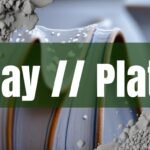GR Pottery Forms are a fantastic tool for potters looking to create consistent and beautiful ceramic pieces, especially dinnerware and serving platters. These forms, typically made from high-density fiberboard (HDF), are designed as wood drape molds that offer a reliable inner structure for shaping clay. Their durability and economical nature, stemming from the cut and beveled fiberboard construction, make them a worthwhile investment for both beginner and experienced potters. You can even consider using GR pottery forms for pottery in the kitchen, to make baking dishes and fermentation crocks. They are especially useful if you’re making a lot of similar pieces, such as when running a pottery business. Check out this comprehensive guide to starting a pottery business for some advice.
Key Steps for Success
Using GR Pottery Forms involves a few key steps to ensure success. First, it’s crucial to prepare your clay. The ideal consistency is a pliable slab, rolled out to a thickness that suits your desired outcome. Next, gently lay the clay slab over the GR Pottery Form, taking care to evenly distribute the clay across the surface. At this stage, you can begin to shape the clay to conform to the form. Use your hands or a soft rib to press the clay against the mold, ensuring that it makes full contact and captures the form’s shape. The beauty of GR Pottery Forms lies in their ability to help you achieve uniformity in your pieces, which is particularly useful when creating sets of plates or bowls. Remember, patience is key; work slowly and methodically to avoid trapping air bubbles or creating thin spots in the clay.
Versatility and Experimentation
One of the great things about GR Pottery Forms is their versatility. You can stack different sizes of circular plate molds to create tiered forms, resulting in unique, angular bowl shapes. Experimenting with different textures and surface treatments is also encouraged. Before draping the clay, consider pressing leaves, fabric, or other textured materials into the slab to add visual interest to your finished piece. You can also use various tools to create patterns or carve designs into the clay while it’s still on the form. This allows for a high degree of customization and artistic expression, even while using a mold to ensure consistent shaping. One method of adding texture is sprigging, which involves adding depth to the pottery.
Experimenting with different textures and surface treatments is also encouraged.
Caring for Your Forms
Caring for your GR Pottery Forms is essential to prolong their lifespan and maintain their effectiveness. Given that these forms are made of wood fiber, it’s important to allow them to dry thoroughly between uses. This prevents the wood from warping or deteriorating over time. After each use, gently wipe down the form with a damp cloth to remove any clay residue. Avoid using excessive water or harsh cleaning chemicals, as these can damage the wood fiber. Store your GR Pottery Forms in a dry, well-ventilated area, away from direct sunlight or extreme temperatures. Proper storage will help prevent warping and ensure that your forms remain in good condition for many years to come.
Troubleshooting Common Challenges
Common challenges encountered when using GR Pottery Forms often revolve around issues with cracking or warping during the drying process. To mitigate these problems, ensure that your clay is evenly hydrated and free of air pockets before draping it over the form. Drying the clay slowly and evenly is also crucial. Cover the piece loosely with plastic to prevent it from drying too quickly, and remove the plastic gradually over several days. If warping occurs, it may be due to uneven drying or stresses in the clay. In some cases, you may be able to gently reshape the piece while it’s still damp, but prevention is always the best approach.





